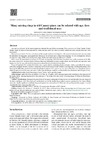Please use this identifier to cite or link to this item:
https://accedacris.ulpgc.es/jspui/handle/10553/40282
| DC Field | Value | Language |
|---|---|---|
| dc.contributor.author | Génova Fuster, Mª del Mar | en_US |
| dc.contributor.author | Santana Jubells, Carlos | en_US |
| dc.contributor.author | Martínez, Begoña | en_US |
| dc.date.accessioned | 2018-06-08T12:28:12Z | - |
| dc.date.available | 2018-06-08T12:28:12Z | - |
| dc.date.issued | 2017 | en_US |
| dc.identifier.issn | 2171-5068 | en_US |
| dc.identifier.uri | https://accedacris.ulpgc.es/handle/10553/40282 | - |
| dc.description.abstract | Aim and area of study: In the present paper we estimated the age of four monumental Pinus canariensis of Gran Canaria (Canary Islands, Spain) by means of tree-ring analysis. Many tree-ring series have been accurately studied and many missing rings have been determined. Material and methods: The trees were dead and the samples analysed were big disks. We measured numerous radii and crossdated the individual tree-ring series, paying particular attention to the existence and location of missing rings. We have distinguished between missing outer rings (MORs) and missing inner rings (MIRs) and analysed the possible causes of both. Main results: We determined an average of 8.8% total missing rings (MRs) for these long-lived trees, with a maximum of 96 MRs in a series of over 500. We have tried to establish a tree-ring chronology on Gran Canaria Island, also having the tree-ring series from Inagua site, but the long individual tree-ring series analysed do not crossdate between them Research highlights: We consider the Canary pine a species hard to conducting dendroecological studies, especially if the samples come from managed old trees, in which a large amount of known and potentially unknown missing rings can hampered dating. Even knowing the difficulties involved in dendrochronological analyses of P. canariensis, we can confirm that it is a long-lived species, which can grow to over 500 years, and some of whose growth changes could be associated with certain historical and ecological events. | en_US |
| dc.language | eng | en_US |
| dc.relation.ispartof | Forest Systems | en_US |
| dc.source | Forest Systems [ISSN 2171-5068], v. 26 (2), article number eSC02 | en_US |
| dc.subject | 2417 Biología vegetal (botánica) | en_US |
| dc.subject.other | Canary Islands | en_US |
| dc.subject.other | Dendrochronology | en_US |
| dc.subject.other | Growth changes | en_US |
| dc.subject.other | Spain | en_US |
| dc.title | Many missing rings in old Canary pines can be related with age, fires and traditional uses | en_US |
| dc.type | info:eu-repo/semantics/Article | es |
| dc.type | Article | es |
| dc.identifier.doi | 10.5424/fs/2017262-10253 | |
| dc.identifier.scopus | 85032028684 | |
| dc.identifier.isi | 000413335800003 | - |
| dc.contributor.authorscopusid | 18037399800 | |
| dc.contributor.authorscopusid | 57196152765 | |
| dc.contributor.authorscopusid | 57196153062 | |
| dc.identifier.issue | 2 | - |
| dc.relation.volume | 26 | - |
| dc.investigacion | Ciencias | en_US |
| dc.type2 | Artículo | en_US |
| dc.contributor.daisngid | 1442910 | |
| dc.contributor.daisngid | 5858941 | |
| dc.contributor.daisngid | 32165432 | |
| dc.contributor.wosstandard | WOS:Genova, M | |
| dc.contributor.wosstandard | WOS:Santana, C | |
| dc.contributor.wosstandard | WOS:Martinez, B | |
| dc.date.coverdate | Enero 2017 | |
| dc.identifier.ulpgc | Sí | es |
| dc.description.sjr | 0,43 | |
| dc.description.jcr | 0,96 | |
| dc.description.sjrq | Q2 | |
| dc.description.jcrq | Q3 | |
| dc.description.scie | SCIE | |
| item.fulltext | Con texto completo | - |
| item.grantfulltext | open | - |
| Appears in Collections: | Artículos | |
SCOPUSTM
Citations
6
checked on Jun 8, 2025
WEB OF SCIENCETM
Citations
5
checked on Jun 8, 2025
Page view(s)
120
checked on Oct 31, 2024
Download(s)
105
checked on Oct 31, 2024
Google ScholarTM
Check
Altmetric
Share
Export metadata
Items in accedaCRIS are protected by copyright, with all rights reserved, unless otherwise indicated.
